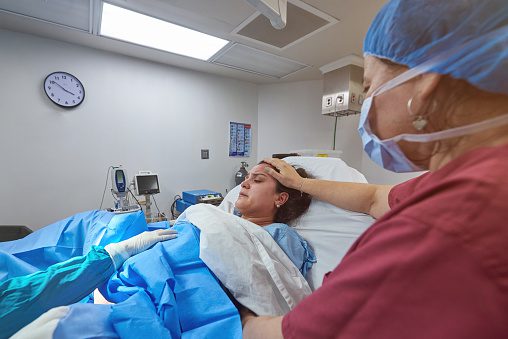
| Labor and Delivery Nurse Key Stats | |
|---|---|
| Education | 4+ Years |
| Job Outlook | 12% |
A Labor and Delivery Nurse is a Registered Nurse who specializes in Labor and Delivery.
They assist with monitoring a woman’s progress during labor and observing the individual’s vital statistics.
In addition, Labor and Delivery Nurses will also monitor the fetus and its vital statistics assuring the health of both newborn and mom are favorable.
Individuals who want to become a Labor and Delivery Nurse will have the ability to handle not only stressful, but rewarding conditions with the birth of a new individual.
With their medical knowledge gleaned from their studies and some innate characteristics, individuals interested in pursuing this profession can experience both personal and professional satisfaction.
Table of Contents
Education Requirements to Become a Labor and Delivery Nurse
Individuals who want to become a Labor and Delivery Nurse will need to become a Registered Nurse (RN) before seeking a specialization in Labor and Deliver.
Labor and Delivery is a specialization that focuses on assisting women patients and their newborns during labor and delivery.
In order to enter the profession as a Registered Nurse, individuals can choose from three common paths.
Individuals can attain a bachelor’s of science degree in nursing (BSN), an associate’s degree in nursing (ADN), or receive a diploma from an accredited nursing program.
In addition, individuals who want to become a Labor and Delivery Nurse will need to secure a license in order to practice.
An associate’s degree (ADN) or a diploma program usually takes approximately 2 to 3 years to complete.
A bachelor’s in nursing (BSN) typically takes about 4 years to complete.
Typical programs include coursework in: psychology, nutrition, chemistry, microbiology, physiology, anatomy as well as courses in liberal arts, social and behavioral sciences.
All programs include supervised clinical experience with bachelor’s programs offering the most clinical experience.
Individuals can gain experience in general nursing or receive specialized training in labor and delivery during their clinical experience.
Individuals who pursue a bachelor’s degree in order to become a Labor and Delivery Nurse will also qualify for better job opportunities.
For example, these individuals will be able to seek opportunities in research, administrative positions, teaching and consulting.
One of the last steps to enter this profession is to become licensed as a registered nurse.
Licensing will depend on the state an individual works in.
In order to seek licensing, individuals will need to complete an accredited program and pass the National Council Licensure Examination.
For more information on this licensing exam, please visit NCLEX Examination.
Labor and Delivery Nurse Job Description
Labor and Delivery Nurses are licensed Registered Nurses that are specialized in providing healthcare to women who are giving birth and to their unborn and newborn babies.
They care for women before, during and after childbirth assuring their patients’ vital statistics are normal.
They will also assist patients who are experiencing difficulties with the birth.
Labor and Delivery Nurses will take their patient’s vital statistics, record any possible symptoms, record medical histories, observe and record patient observations, consult with doctors or other healthcare professionals, administer medicines or treatments, assist doctors during caesarean sections, teach new mother’s about infant care and discuss any possible postpartum health complications.
Labor and Delivery Nurse Salary and Career Path
In 2012, the median salary for Registered Nurses, which includes the Labor and Delivery Nurse profession, was approximately $65,470 per year.
Exact wages will depend on several factors including level of experience and the type of health care facility an individual is employed in.
For example, individuals working for the government can expect to earn a median salary of approximately $68,540 while individuals working in a physician’s office can expect a median salary of $58,420 per year.
The job outlook for all Registered Nurses, also including Labor and Delivery Nurses is expected to increase by 19 percent through the year 2022.
This job growth is considered faster than average when compared to other professions.
Individuals with a bachelor’s degree and more experience will have better job opportunities.
Individuals pursuing a career as a Labor and Delivery Nurse have many things to look forward to including a healthy job outlook, competitive wages and the ability to work with women and families welcoming a new family member.
![]() The below information is based on the 2023 BLS national averages.
The below information is based on the 2023 BLS national averages.
National Average Salary
$94,480Average Salary by State
| State | Avg. Annual Salary |
|---|---|
| Alabama | $71,370 |
| Alaska | $109,210 |
| Arizona | $91,430 |
| Arkansas | $72,900 |
| California | $137,690 |
| Colorado | $91,730 |
| Connecticut | $101,840 |
| Delaware | $94,670 |
| District of Columbia | $106,850 |
| Florida | $84,760 |
| Georgia | $90,000 |
| Hawaii | $119,710 |
| Idaho | $83,090 |
| Illinois | $87,650 |
| Indiana | $82,700 |
| Iowa | $74,610 |
| Kansas | $76,240 |
| Kentucky | $81,770 |
| Louisiana | $80,760 |
| Maine | $84,340 |
| Maryland | $92,090 |
| Massachusetts | $108,850 |
| Michigan | $86,210 |
| Minnesota | $94,830 |
| Mississippi | $75,510 |
| Missouri | $77,590 |
| Montana | $82,950 |
| Nebraska | $79,780 |
| Nevada | $97,700 |
| New Hampshire | $89,410 |
| New Jersey | $101,960 |
| New Mexico | $92,140 |
| New York | $106,620 |
| North Carolina | $82,530 |
| North Dakota | $79,190 |
| Ohio | $84,430 |
| Oklahoma | $82,110 |
| Oregon | $113,440 |
| Pennsylvania | $87,530 |
| Rhode Island | $95,070 |
| South Carolina | $81,390 |
| South Dakota | $69,030 |
| Tennessee | $78,240 |
| Texas | $90,210 |
| Utah | $83,100 |
| Vermont | $88,380 |
| Virginia | $88,350 |
| Washington | $111,030 |
| West Virginia | $75,990 |
| Wisconsin | $87,220 |
| Wyoming | $83,990 |
| Guam | - NA - |
| Puerto Rico | $39,130 |
| Virgin Islands | $70,410 |
The top earning state in the field is California, where the average salary is $137,690.
These are the top 5 highest-paying states in the field:
* Employment conditions in your area may vary.
Frequently Asked Questions
What is a labor and delivery nurse?
Labor and delivery nurses are registered nurses who prepare women for childbirth, assist the patient and the doctor during delivery and care for the mother and newborn after birth.
While helping pregnant women get ready for childbirth, labor and delivery nurses monitor the expectant mother’s blood pressure and coach her to breathe during contractions.
They may also monitor the baby’s heart rate to make sure the baby is healthy.
Labor and delivery nurses are also responsible for administering the epidural or other medications the future mother may need.
They can also work as scrub nurses in the operating room if the expectant mother undergoes a c-section.
Labor and delivery nurses may also be trained in neonatal resuscitation and fetal monitoring.
After delivery, labor and delivery nurses assist women while they learn how to breastfeed and care for the infant but also ensure that the mother receives the post-delivery care she needs.
Nurses who are employed by hospitals usually work in shifts to care for women and babies who need round-the-clock attention.
How much does a labor and delivery nurse make?
According to the Bureau of Labor Statistics, the median annual wage for registered nurses, in general, was $71,730 in May 2018.
Salaries vary based on many factors and labor and delivery nurses can make anywhere between less than $50,000 and more than $100,000 a year.
How much does it cost to become a labor and delivery nurse?
Labor and delivery nurses are registered nurses who specialize in assisting women during labor and delivery.
Registered nurses need a bachelor’s degree, an associate’s degree or a diploma in nursing and a state license.
Tuition costs vary depending on the school you choose and the program itself.
Associate’s degree programs in nursing cost somewhere in the range of $20,000-$50,000 while bachelor’s degree programs can cost anywhere between $40,000 and more than $100,000 a year.
Bachelor’s degree programs may be required for administrative positions.
What is the demand for labor and delivery nurses?
According to the Bureau of Labor Statistics, the demand for registered nurses, in general, is projected to grow 12 percent from 2018 to 2028.
Labor and delivery nurses will continue to be needed to assist women during labor, childbirth and after delivery.
Nurses who hold a bachelor’s degree in nursing may have better job prospects.
How long does it take to become a labor and delivery nurse?
In order to become a labor and delivery nurse, you must first become a licensed registered nurse.
Registered nurses need a bachelor’s degree, an associate’s degree or a diploma in nursing.
Bachelor’s degree programs usually can be completed in 4 years, while associate’s degree programs can be completed in 2-3 years.
Registered nurses also need a state license in order to be able to practice; licensure requirements include graduating from an accredited program and passing the NCLEX-RN exam.
If you want to become a clinical nurse specialist you will also need a master’s degree in nursing and around 1 year or more of experience working as a registered nurse.
Several professional associations offer certification for nurses who want to specialize in a specific field, such as ambulatory care or pediatrics.













